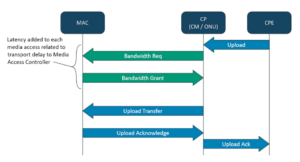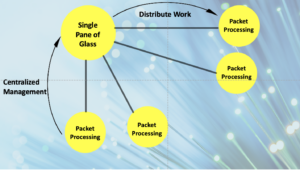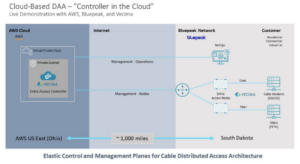Vecima Blog – Connecting Communities with the Cloud
February 16, 2022


 Vecima believes that the future of last-mile Access is Edge computing for data plane processing coupled with centralized management, unified on Ethernet-based transport and common abstraction data models.
Vecima and Bluepeak recently teamed up to deploy an innovative new cloud-based Distributed Access Architecture (DAA). Vecima is constantly striving to produce the highest quality unified access technologies to enable an agile future of connecting everyone. Bluepeak is constantly on the lookout for innovative ways to increase their access network reach while reducing the costs of each added home passed. It was a perfect match, and together we deployed an Remote MACPHY system using the Entra SC-2D Access Node with an Entra Access Controller hosted in Amazon Web Services (AWS) Virtual Private Cloud.
Vecima provides both R-PHY and R-MACPHY/FMA based DAA solutions and believe each DAA approach has benefits and trade-offs. Working with Bluepeak, we investigated their requirements and network design to determine that an R-MACPHY/FMA design was the best DAA solution for their needs. R-MACPHY based DAA reduces or removes the need for network-wide timing and pushes customer-traffic processing to the network edge, which allows for the central management component of DAA to be readily virtualized in low-cost compute instances.
Last-mile physical and media access control is a parallel and distributed computing technology problem. Enabling packet processing at the edge of the network allows the access-specific constraints of the last-mile to be isolated in the network at the place of most relevance. Edge computing provides opportunities for latency reduction through reduction of round-trip times between the customer premises and the compute function. Edge computing of the MAC (media access controller) in DOCSIS and PON is especially relevant due to the shared point-to-multipoint nature of these technologies and the requirement for upstream transmissions to be mediated by the MAC.
Vecima believes that the future of last-mile Access is Edge computing for data plane processing coupled with centralized management, unified on Ethernet-based transport and common abstraction data models.
Vecima and Bluepeak recently teamed up to deploy an innovative new cloud-based Distributed Access Architecture (DAA). Vecima is constantly striving to produce the highest quality unified access technologies to enable an agile future of connecting everyone. Bluepeak is constantly on the lookout for innovative ways to increase their access network reach while reducing the costs of each added home passed. It was a perfect match, and together we deployed an Remote MACPHY system using the Entra SC-2D Access Node with an Entra Access Controller hosted in Amazon Web Services (AWS) Virtual Private Cloud.
Vecima provides both R-PHY and R-MACPHY/FMA based DAA solutions and believe each DAA approach has benefits and trade-offs. Working with Bluepeak, we investigated their requirements and network design to determine that an R-MACPHY/FMA design was the best DAA solution for their needs. R-MACPHY based DAA reduces or removes the need for network-wide timing and pushes customer-traffic processing to the network edge, which allows for the central management component of DAA to be readily virtualized in low-cost compute instances.
Last-mile physical and media access control is a parallel and distributed computing technology problem. Enabling packet processing at the edge of the network allows the access-specific constraints of the last-mile to be isolated in the network at the place of most relevance. Edge computing provides opportunities for latency reduction through reduction of round-trip times between the customer premises and the compute function. Edge computing of the MAC (media access controller) in DOCSIS and PON is especially relevant due to the shared point-to-multipoint nature of these technologies and the requirement for upstream transmissions to be mediated by the MAC.
 Any reduction in the transport time between the customer premises equipment and the MAC has a direct, non-negligible, reduction in the shared-access grant times. As interactive entertainment purchasing decisions continue to move toward gaming and the Metaverse, latency performance of Operator networks will come to drive subscription decisions of customers.
A major concern of Edge compute is the risk of increased maintenance burden and complexity for network operators. If processing is distributed widely within a network with many parallel applications operating concurrently it’s not practical to manage each of those components separately. A key aspect of any distributed Edge compute architecture is a centralized management function. The centralized management function aggregates configuration and operational data allowing for a single source-of-truth and a single-pane-of-glass and enables support scaling through automation and network programmability.
Any reduction in the transport time between the customer premises equipment and the MAC has a direct, non-negligible, reduction in the shared-access grant times. As interactive entertainment purchasing decisions continue to move toward gaming and the Metaverse, latency performance of Operator networks will come to drive subscription decisions of customers.
A major concern of Edge compute is the risk of increased maintenance burden and complexity for network operators. If processing is distributed widely within a network with many parallel applications operating concurrently it’s not practical to manage each of those components separately. A key aspect of any distributed Edge compute architecture is a centralized management function. The centralized management function aggregates configuration and operational data allowing for a single source-of-truth and a single-pane-of-glass and enables support scaling through automation and network programmability.

 In this deployment the Entra Access Controller (EAC) is deployed into a Private subnet in the US East availability zone with an AWS site-to-site VPN. Hosting the EAC in AWS means that no last-mile hardware needs to be deployed into hub or headend sites. The environmentally hardened Entra Access Nodes are strand-deployed in remote locations with a TLS/IP connection to the EAC through the site-to-site VPN. Security is applied to the AWS Virtual Private Cloud to ensure the AWS resources act as an extension to the Bluepeak network and the existing security resources. In DOCSIS Remote MACPHY, such as deployed with Bluepeak, the DOCSIS last mile is terminated in the remote Node location and subscriber traffic is directly available at the first hop switching element. No subscriber traffic needs to be routed to the Entra Access Controller, which allows subscriber traffic to be redirected to the most immediate Point-of-Presence for Internet routing and reduces Cloud transit costs from the total-cost-of-ownership.
Cable operators immediately benefit from AWS scale, security, and reliability without having to build and manage on-premises compute and cloud environments while also using edge computing to reduce latency and increase bandwidth on the Last-mile Access portion of their network. The Edge-based DOCSIS MAC, supported by CableLabs FMA standardization, distributes workloads throughout an operator network reducing latency and power consumption while delivering blazingly fast full-spectrum DOCSIS 3.1 functions to customers. The cloud-based EAC centralizes configuration, policy, and operational metrics to a single pane-of-glass increasing service agility and reducing network operation costs.
This successful deployment is the first step in an agile journey to cost-effective community-focused access networks.
If you would like to have a deeper discussion on these topics, please reach out to me at douglas.johnson@Vecima.com
In this deployment the Entra Access Controller (EAC) is deployed into a Private subnet in the US East availability zone with an AWS site-to-site VPN. Hosting the EAC in AWS means that no last-mile hardware needs to be deployed into hub or headend sites. The environmentally hardened Entra Access Nodes are strand-deployed in remote locations with a TLS/IP connection to the EAC through the site-to-site VPN. Security is applied to the AWS Virtual Private Cloud to ensure the AWS resources act as an extension to the Bluepeak network and the existing security resources. In DOCSIS Remote MACPHY, such as deployed with Bluepeak, the DOCSIS last mile is terminated in the remote Node location and subscriber traffic is directly available at the first hop switching element. No subscriber traffic needs to be routed to the Entra Access Controller, which allows subscriber traffic to be redirected to the most immediate Point-of-Presence for Internet routing and reduces Cloud transit costs from the total-cost-of-ownership.
Cable operators immediately benefit from AWS scale, security, and reliability without having to build and manage on-premises compute and cloud environments while also using edge computing to reduce latency and increase bandwidth on the Last-mile Access portion of their network. The Edge-based DOCSIS MAC, supported by CableLabs FMA standardization, distributes workloads throughout an operator network reducing latency and power consumption while delivering blazingly fast full-spectrum DOCSIS 3.1 functions to customers. The cloud-based EAC centralizes configuration, policy, and operational metrics to a single pane-of-glass increasing service agility and reducing network operation costs.
This successful deployment is the first step in an agile journey to cost-effective community-focused access networks.
If you would like to have a deeper discussion on these topics, please reach out to me at douglas.johnson@Vecima.com
We help our customers evolve their networks with cloud-based solutions that deliver ground-breaking speed, superior video quality, and exciting new services to their subscribers.
Contact Us